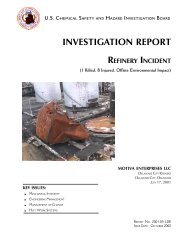CTA Report, Draft 1, ISP Review - US Chemical Safety and Hazard ...
CTA Report, Draft 1, ISP Review - US Chemical Safety and Hazard ...
CTA Report, Draft 1, ISP Review - US Chemical Safety and Hazard ...
You also want an ePaper? Increase the reach of your titles
YUMPU automatically turns print PDFs into web optimized ePapers that Google loves.
Phenolic resin dusts should be regarded as explosible <strong>and</strong> liable to give rise to a dust<br />
explosion hazard provided the concentration in air is very high, i.e., 20 [g/m 3 ] <strong>and</strong> the<br />
ignition temperature of 450°C is reached.<br />
This fact sheet was provided to Borden <strong>Chemical</strong> manufacturing, sales, marketing, <strong>and</strong> research <strong>and</strong><br />
development personnel. It was not systematically distributed to Borden <strong>Chemical</strong> customers, <strong>and</strong> it was<br />
not provided to <strong>CTA</strong>.<br />
In April 2000, Borden <strong>Chemical</strong> prepared a draft “Dear Customer” letter to discuss the Jahn Foundry<br />
explosion, which involved a Borden <strong>Chemical</strong> Durite phenolic resin (Section 8.8.1). The letter listed the<br />
causal factors that led to the explosion, as concluded by a joint OSHA/Massachusetts Department of Fire<br />
Services/Springfield Arson <strong>and</strong> Bomb Squad report. The draft letter recommended that Borden <strong>Chemical</strong><br />
customers follow good housekeeping practices <strong>and</strong> the requirements of NFPA 654 to prevent dust<br />
explosions. A copy of the joint investigation report was to be attached; however, Borden <strong>Chemical</strong> did<br />
not send the letter or the report. Also, Borden <strong>Chemical</strong> reviewed the language on its MSDSs <strong>and</strong> labels<br />
for Durite resins, but determined that no changes were needed.<br />
In June of 2004, more than one year after the <strong>CTA</strong> explosion, Borden <strong>Chemical</strong> distributed safe h<strong>and</strong>ling<br />
guidelines (8 pages) to its phenolic resin customers entitled Phenolic Resin/Powders, Flakes <strong>and</strong><br />
Pastilles: Dust <strong>Hazard</strong>s <strong>and</strong> Recommended Control Practices. These guidelines include: a discussion of<br />
the hazardous properties of phenolic resins, including the conditions needed for a dust explosion; typical<br />
material characteristics (e.g., Kst, MIE, MEC, Pmax); protective measures; <strong>and</strong> NFPA 654 excerpts<br />
(including information on dust control, inspection, maintenance, <strong>and</strong> training).<br />
8.2.3.2 Borden <strong>Chemical</strong>’s Product Stewardship Efforts With <strong>CTA</strong> Acoustics<br />
A Borden <strong>Chemical</strong> safety engineer stated that in 1995 he sent a letter addressed to <strong>CTA</strong> to follow up on a<br />
telephone conversation with the <strong>CTA</strong> engineering manager concerning a proposed process change<br />
involving Borden <strong>Chemical</strong> phenolic resins. In the letter, the Borden <strong>Chemical</strong> safety engineer advised<br />
68









